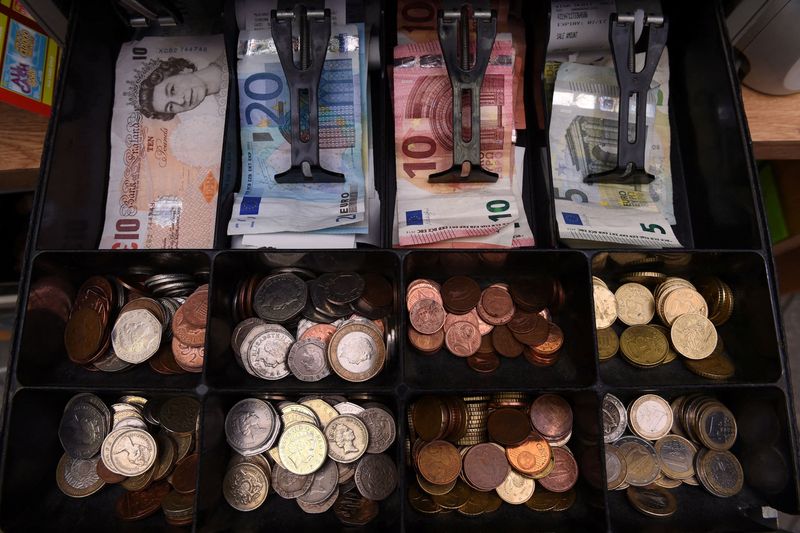 © Reuters. FILE PHOTO: A shop cash register is seen with both Sterling and Euro currency in the till at the border town of Pettigo, Ireland October 14, 2016. REUTERS/Clodagh Kilcoyne
© Reuters. FILE PHOTO: A shop cash register is seen with both Sterling and Euro currency in the till at the border town of Pettigo, Ireland October 14, 2016. REUTERS/Clodagh Kilcoyne
By John McCrank and Gertrude Chavez-Dreyfuss
NEW YORK (Reuters) -The euro on Tuesday climbed from 22-month lows against the U.S. dollar hit the previous session, lifted in part by expectations that the euro zone will increase fiscal spending to help offset the economic effects of Russia's invasion of Ukraine.
Investors were also hesitant to sell the euro ahead of a European Central Bank policy meeting on Thursday. The prospect of stagflation has prompted economists to suggest policymakers might delay rate hikes until late in the year.
Europe's single currency, which has been pummeled since the start of the latest geopolitical turmoil, also gained versus other currencies such as the yen, Swiss franc and sterling.
Bloomberg News reported on Tuesday that the European Union plans as soon as this week to jointly issue bonds on a potentially massive scale to finance energy and defense spending.
Franziska Palmas, markets economist at Capital Economics, said that if confirmed the news would be positive for euro zone assets, but it would not be enough to sustain their recovery.
Joe Manimbo, senior market analyst at Western Union (NYSE:WU) Business Solutions in Washington, believes the euro appears to have found a "tentative bottom," with some investors reluctant to test new lows ahead of the ECB meeting.
"There is a risk that the ECB president may acknowledge euro weakness as among the headwinds facing the bloc's economy. That's been enough to offer the euro at least a momentary reprieve," Manimbo added.
In addition, the international oil benchmark Brent crude backed off Monday's 14-year high of just under $140 per barrel, which helped boost euro sentiment. Brent was still up 4.3% on Tuesday at $128.50 per barrel.
The euro regained some ground after five sessions of declines versus the dollar. It was up more than a cent from a trough of $1.0806 on Monday, its lowest since March 2020 when the COVID-19 pandemic gripped Europe.
The single currency was last up 0.5% at $1.0906.
The euro briefly traded at parity with the Swiss franc on Monday for the first time in seven years. It rose 0.9% on Tuesday to 1.0134 francs.
Traders are expecting choppy markets over the next few months, with euro/dollar volatility gauges at their highest since the market chaos of March 2020.
As the euro gained, the dollar index, which measures the greenback against a basket of six global peers, was flat to slightly lower at 99.15.
That said, the safe-haven dollar remains an in-demand asset despite Tuesday's slight pullback. Since Russia's invasion on Feb. 24, the dollar has gained around 3.3% as the crisis has intensified.
Besides the commodities' rally, the war and subsequent Western sanctions have crushed Russian assets, with the rouble falling to a record low of 160 to the dollar in erratic offshore trade on Monday. The rouble on Tuesday though firmed 5.9% versus the greenback, which fell to 127 roubles.
========================================================
Currency bid prices at 3:33PM (2033 GMT)
Description RIC Last U.S. Close Pct Change YTD Pct High Bid Low Bid
Previous Change
Session
Dollar index 99.0600 99.1720 -0.09% 3.551% +99.3270 +98.7040
Euro/Dollar $1.0904 $1.0854 +0.47% -4.09% +$1.0958 +$1.0849
Dollar/Yen 115.6750 115.3050 +0.34% +0.50% +115.7850 +115.2900
Euro/Yen 126.14 125.14 +0.80% -3.21% +126.7300 +125.1200
Dollar/Swiss 0.9292 0.9254 +0.45% +1.91% +0.9306 +0.9250
Sterling/Dollar $1.3102 $1.3105 -0.02% -3.12% +$1.3144 +$1.3083
Dollar/Canadian 1.2886 1.2821 +0.51% +1.92% +1.2900 +1.2799
Aussie/Dollar $0.7273 $0.7315 -0.54% +0.08% +$0.7348 +$0.7245
Euro/Swiss 1.0132 1.0046 +0.86% -2.30% +1.0177 +1.0047
Euro/Sterling 0.8320 0.8285 +0.42% -0.95% +0.8346 +0.8279
NZ $0.6809 $0.6823 -0.15% -0.46% +$0.6850 +$0.6799
Dollar/Dollar
Dollar/Norway 8.9765 9.0430 -0.70% +1.93% +9.0780 +8.9455
Euro/Norway 9.7885 9.8310 -0.43% -2.24% +9.8566 +9.7475
Dollar/Sweden 9.9301 9.9924 -0.26% +10.12% +10.0356 +9.8533
Euro/Sweden 10.8271 10.8552 -0.26% +5.80% +10.8938 +10.7939

